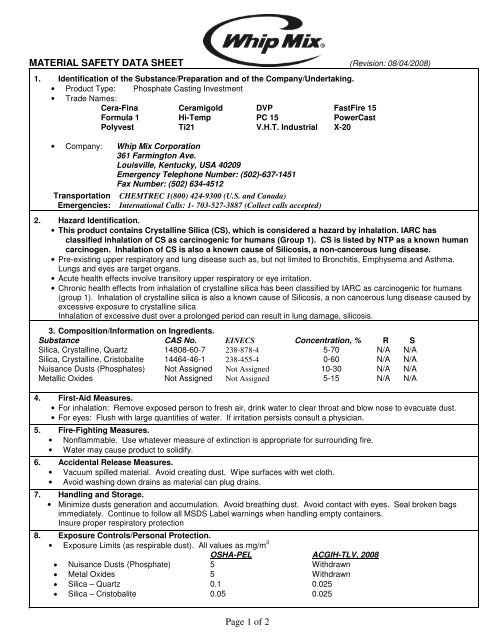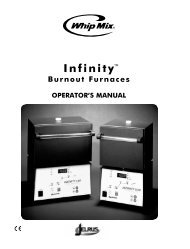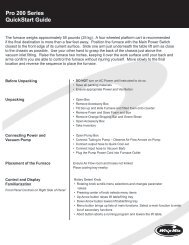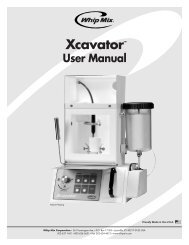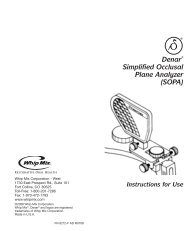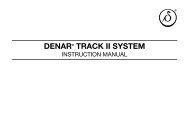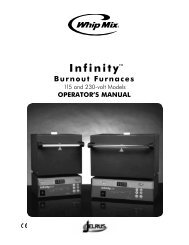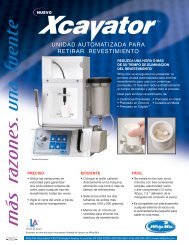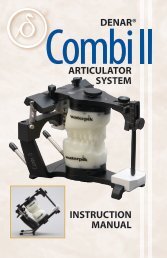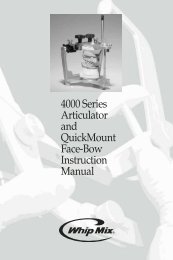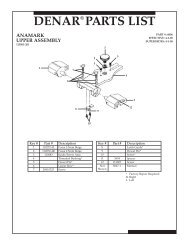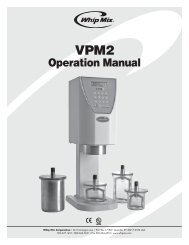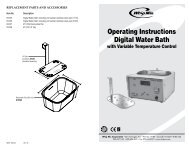Page 1 of 2 MATERIAL SAFETY DATA SHEET - Whip Mix
Page 1 of 2 MATERIAL SAFETY DATA SHEET - Whip Mix
Page 1 of 2 MATERIAL SAFETY DATA SHEET - Whip Mix
You also want an ePaper? Increase the reach of your titles
YUMPU automatically turns print PDFs into web optimized ePapers that Google loves.
<strong>MATERIAL</strong> <strong>SAFETY</strong> <strong>DATA</strong> <strong>SHEET</strong> (Revision: 08/04/2008)<br />
1. Identification <strong>of</strong> the Substance/Preparation and <strong>of</strong> the Company/Undertaking.<br />
• Product Type: Phosphate Casting Investment<br />
• Trade Names:<br />
Cera-Fina Ceramigold DVP FastFire 15<br />
Formula 1 Hi-Temp PC 15 PowerCast<br />
Polyvest Ti21 V.H.T. Industrial X-20<br />
• Company: <strong>Whip</strong> <strong>Mix</strong> Corporation<br />
361 Farmington Ave.<br />
Louisville, Kentucky, USA 40209<br />
Emergency Telephone Number: (502)-637-1451<br />
Fax Number: (502) 634-4512<br />
Transportation<br />
Emergencies:<br />
CHEMTREC 1(800) 424-9300 (U.S. and Canada)<br />
International Calls: 1- 703-527-3887 (Collect calls accepted)<br />
2. Hazard Identification.<br />
• This product contains Crystalline Silica (CS), which is considered a hazard by inhalation. IARC has<br />
classified inhalation <strong>of</strong> CS as carcinogenic for humans (Group 1). CS is listed by NTP as a known human<br />
carcinogen. Inhalation <strong>of</strong> CS is also a known cause <strong>of</strong> Silicosis, a non-cancerous lung disease.<br />
• Pre-existing upper respiratory and lung disease such as, but not limited to Bronchitis, Emphysema and Asthma.<br />
Lungs and eyes are target organs.<br />
• Acute health effects involve transitory upper respiratory or eye irritation.<br />
• Chronic health effects from inhalation <strong>of</strong> crystalline silica has been classified by IARC as carcinogenic for humans<br />
(group 1). Inhalation <strong>of</strong> crystalline silica is also a known cause <strong>of</strong> Silicosis, a non cancerous lung disease caused by<br />
excessive exposure to crystalline silica<br />
Inhalation <strong>of</strong> excessive dust over a prolonged period can result in lung damage, silicosis.<br />
3. Composition/Information on Ingredients.<br />
Substance CAS No. EINECS Concentration, % R S<br />
Silica, Crystalline, Quartz 14808-60-7 238-878-4 5-70 N/A N/A<br />
Silica, Crystalline, Cristobalite 14464-46-1 238-455-4 0-60 N/A N/A<br />
Nuisance Dusts (Phosphates) Not Assigned Not Assigned 10-30 N/A N/A<br />
Metallic Oxides Not Assigned Not Assigned 5-15 N/A N/A<br />
4. First-Aid Measures.<br />
• For inhalation: Remove exposed person to fresh air, drink water to clear throat and blow nose to evacuate dust.<br />
• For eyes: Flush with large quantities <strong>of</strong> water. If irritation persists consult a physician.<br />
5. Fire-Fighting Measures.<br />
• Nonflammable. Use whatever measure <strong>of</strong> extinction is appropriate for surrounding fire.<br />
• Water may cause product to solidify.<br />
6. Accidental Release Measures.<br />
• Vacuum spilled material. Avoid creating dust. Wipe surfaces with wet cloth.<br />
• Avoid washing down drains as material can plug drains.<br />
7. Handling and Storage.<br />
• Minimize dusts generation and accumulation. Avoid breathing dust. Avoid contact with eyes. Seal broken bags<br />
immediately. Continue to follow all MSDS Label warnings when handling empty containers.<br />
Insure proper respiratory protection<br />
8. Exposure Controls/Personal Protection.<br />
• Exposure Limits (as respirable dust). All values as mg/m 3<br />
• OSHA-PEL ACGIH-TLV, 2008<br />
• Nuisance Dusts (Phosphate) 5 Withdrawn<br />
• Metal Oxides 5 Withdrawn<br />
• Silica – Quartz 0.1 0.025<br />
• Silica – Cristobalite 0.05 0.025<br />
<strong>Page</strong> 1 <strong>of</strong> 2
• Personal protective equipment: None required during normal laboratory use.<br />
• Engineering controls: Use local ventilation to keep employee exposure to respirable dust below 0.025 mg/m 3 .<br />
• Respirator: Use respirator approved by NIOSH/MSHA – 1/2 face with dust/mist cartridges for exposures up to 10<br />
times exposure limit.<br />
9. Physical and Chemical Properties.<br />
• Solid, odorless powder, with variety <strong>of</strong> colors<br />
Vapor pressure (mmHg)<br />
Not Applicable<br />
Vapor density (air=1)<br />
Not Applicable<br />
Evaporation rate<br />
Not Applicable<br />
Boiling point ºC<br />
Not Applicable<br />
Freezing point ºC<br />
Not Applicable<br />
pH<br />
Not Applicable<br />
Specific gravity<br />
Not Applicable<br />
Flammability<br />
Not Applicable<br />
Flash point ºC<br />
Not Applicable<br />
• No dangerous reactions are known to occur with correct handling and storage.<br />
10. Stability and Reactivity.<br />
• Basically stable, may solidify if contacted by water.<br />
• Incompatible with hydr<strong>of</strong>luoric acid.<br />
• No hazardous decomposition products.<br />
11. Toxicological Information.<br />
• Route <strong>of</strong> entry: Inhalation.<br />
• Effects <strong>of</strong> acute exposure: None known.<br />
• Inhalation <strong>of</strong> excessive dust over a prolonged period can result in lung damage, Silicosis.<br />
• Carcinogenicity: The International Agency for Research on cancer (IARC) reports inhaled crystalline silica is a<br />
Group 1 carcinogen to humans. NTP has listed crystalline silica as carcinogen.<br />
• Synergistic products: Mycobacterium Tuberculosis.<br />
12. Ecological Data.<br />
• No ecotoxicological studies are available. Generally considered chemically inert in the environment. Not<br />
dangerous to water.<br />
13. Disposal Considerations.<br />
• Waste is not hazardous as defined by RCRA (40 CFR 261). Other state and local regulation may vary; consult<br />
local agencies as needed. Used material, which has become contaminated, may have significantly different<br />
characteristics based on contaminates and should be evaluated accordingly.<br />
14. Transport Information.<br />
• No special transport requirements, non dangerous goods.<br />
15. Regulatory Information.<br />
• OSHA Hazard Communications Standard, 29 CFR 1910.1200: Contained material considered hazardous.<br />
• RCRA: This material is not defined as hazardous water, per 40 CFR 261.<br />
• TSCA: These products contain materials listed in the TSCA inventory and is not otherwise regulated by TSCA Sec.<br />
4, 5, 6, 7 or 12.<br />
• CERCLA: Materials not reportable under CERCLA. Local requirements may vary.<br />
• SARA: 311/312 hazard categories - immediate and delayed health, 313 reportable ingredients - none<br />
• California Proposition 65: Investments contain Crystalline Silica known to the state <strong>of</strong> California to cause cancer.<br />
16. Other Information.<br />
• HMIS Rating: Health 3 Flammability 0 Reactivity 0 Other 0<br />
Hazard: 4-Severe; 3-Serious; 2-Moderate; 1-Slight; 0-Minimum<br />
Prepared By: Donna, Ringo, CIH<br />
Translated By:<br />
Date: 8/4/2008 Date:<br />
CPL30532i\msds\phosphat.wpd(rev. 08/04/2008<br />
<strong>Page</strong> 2 <strong>of</strong> 2


